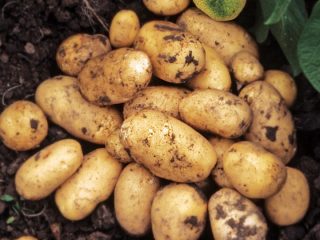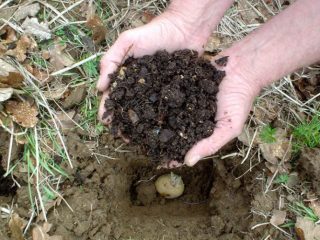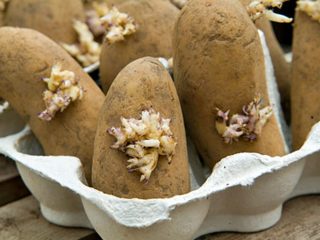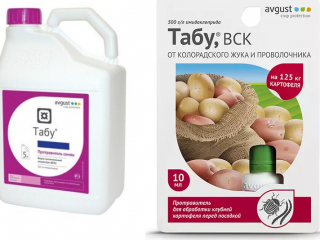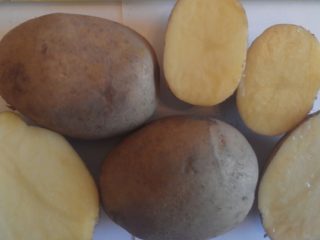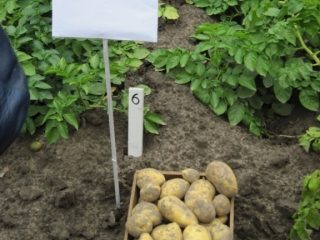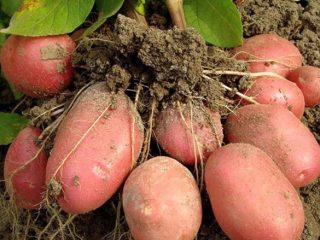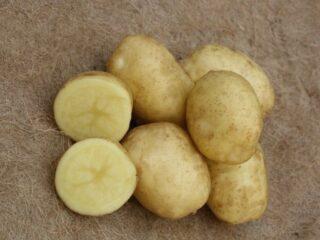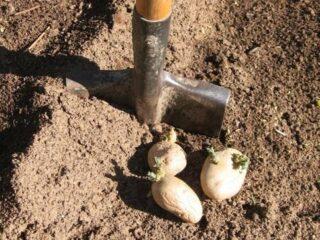Content
Potatoes cracking in the ground is a problem that vegetable growers and farmers often have to face. It can arise due to several reasons, usually associated with the organization of improper or insufficient care of crop plantings. Gnarled potatoes in cracks can cause a lot of problems for the farm. The defect significantly reduces the marketability of the crop, reduces demand and revenue. Such a vegetable can no longer be used as planting material, and sometimes even eaten.
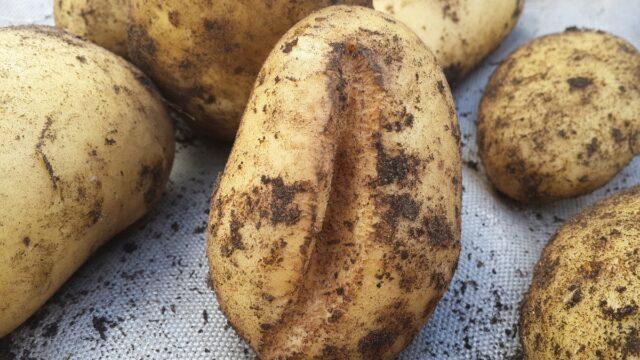
Often potatoes in cracks have to be disposed of
Causes of cracks in potato tubers
The reason why potatoes crack in the soil is due to various factors and circumstances. This can be caused by poor-quality planting material and unfavorable climatic conditions, or by improper care or dangerous diseases or insect infestations.To understand why potatoes grew ugly and cracked, you should learn more about each of the possible reasons.
Poor quality planting material
Cracks in tubers often occur if bad potatoes were used during planting. The culture is prone to degeneration, as a result of which, during its growth, the appearance gradually deteriorates. The main reasons for this are growing conditions. With each season, plants react worse to fertilizing, potatoes become smaller, cracks appear on them, and yields drop. As a result, after a few years the tubers become unsuitable for planting.

To prevent cracks in the potatoes, planting material is changed every 3-5 years
Unfavorable weather
Cracks in tubers can also appear due to factors that do not depend on a person. For example, due to sudden changes in weather: prolonged drought or heavy and frequent rains. Thus, due to constant fluctuations in temperature, the crop becomes deformed.
Improper watering
Another reason for the appearance of cracks in potatoes is non-compliance with the rules of moistening the crop. Not all gardeners know that before sprouts appear on the surface of the ground, plantings cannot be watered. This rule is observed because the plants have not yet become strong and in damp soil can succumb to the process of rotting. They begin to moisten the area only when the potatoes sprout. At this time, the crop is gaining green mass and needs abundant watering. Further irrigation is carried out as needed.
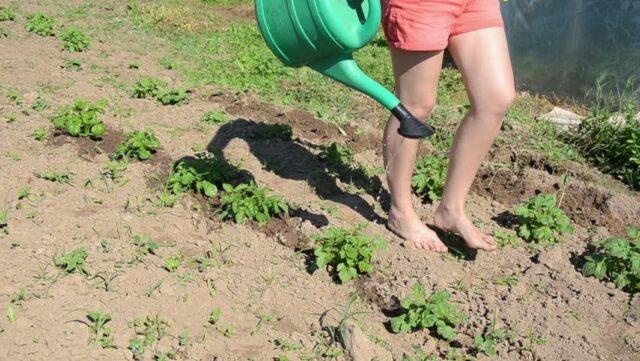
Violation of the irrigation regime often leads to cracks in early varieties of crops
Unsuitable soil
Tubers crack if they grow in unsuitable soil, most often clay. Such soil is problematic to process; on rainy days it retains moisture in the top layer and does not allow it to pass further, and on dry days it forms a dry crust on the surface. At the same time, the root system of the plant suffers from oxygen deficiency, and due to excess moisture it rots. As a result, the potatoes grow crooked and with cracks.
Diseases
The vital activity of microorganisms also has a significant impact on the appearance of potatoes. Cracks in vegetables and other defects occur as a result of the harmful effects of bacteria, fungi and viruses. Most often, the crop cracks if it becomes infected with scab, blackleg or fomoz.
Pests
Insects also have a negative impact on the yield and quality of potatoes. In particular, mole crickets, Colorado potato beetles, potato moths, and wireworms cause damage to plantings. Cracks in potatoes can also appear under the influence of nematodes.
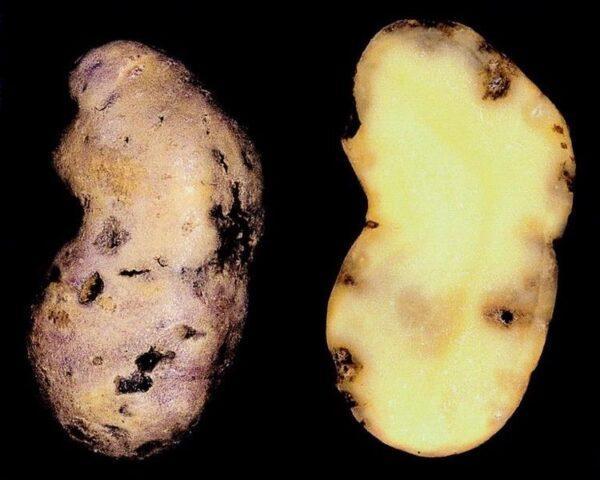
Tubers damaged by nematodes have rotten pulp and are unsuitable for food
Preventing cracks in potatoes
In order for potatoes not only to have excellent taste, but also to be beautiful, you must adhere to the rules for growing them. The main ones are the following:
- compliance with agricultural technology;
- soil moisture control;
- use of high-quality planting material;
- carrying out preventive measures to prevent diseases and pests;
- planting varieties resistant to cracking.
All these recommendations should be followed together.Ignoring at least one rule can lead to the fact that the potatoes begin to crack as they grow.
Compliance with growing rules
Competent agricultural technology for growing potatoes includes several stages:
- Proper soil preparation. You should start preparing the area for potatoes in the fall. To do this, you need to dig it up to a depth of one shovel, add sawdust, nitrogen-containing compounds or urea. Do not fertilize potatoes with fresh manure. To increase the lightness of the soil and its permeability, you can add river sand to it at the rate of one bucket per square meter. To deoxidize the soil, it is recommended to add wood ash, chalk or lime. In addition, in order to improve the chemical composition of the soil, the area where potatoes will grow can be sown with green manure. Rye, mustard, and phacelia are excellent for this purpose.
- Compliance with landing rules. The material should be selected from the best specimens, without damage or cracks. Before planting, tubers need to be treated for diseases; to do this, soak them in a solution of Fitosporin, Baktofit or potassium permanganate.
- Organizing proper care. Cracks in tubers often occur due to improper moisture. The crop needs two abundant waterings per season: a week after emergence and at the initial stage of tuber formation. Planting also requires timely hilling of the beds, loosening the soil and freeing it from weeds.

Even weeds can cause cracks to appear on potatoes.
Disease Control
In order not to encounter a problem when potatoes crack inside, prevention or timely control of diseases should be carried out.To do this, in the fall, the beds are sown with green manure, and after they grow to 15 cm, the area is dug up. This helps to destroy pathogens of microbes and fungi. Before planting, potatoes are treated with Fitosporin and then sprayed with the same preparation three times a season.
If the potato has already been scabbed, then it is treated with Colfugo or Mancozeb, the black leg is removed with Vitaros, Hom or garlic infusion, and for fomoz - with Maxim, Baktofit.
Pest Control
To repel pests from potatoes that contribute to the appearance of cracks on them, many vegetable growers resort to traditional methods. For example, crops that have a specific smell are planted in the rows: calendula, marigolds, sweet clover, nasturtium. Chemicals are used to get rid of existing pests.
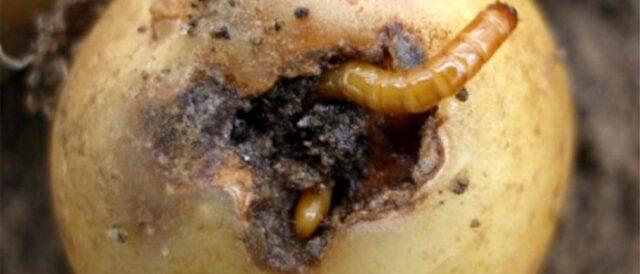
The nematode is considered the most dangerous insect and the most difficult to combat.
What to do if cracks appear on potatoes
If cracks have already formed on the potatoes, there is no way to correct the situation. But tubers are not always subject to disposal; in some cases, despite the fact that they have lost their marketable appearance, they can be eaten. It is advisable to use it immediately after collection.
Also, part of the harvest, which consists of small and crooked potatoes, as well as tubers with cracks, can be used to feed livestock.
Is it possible to eat these potatoes?
If a potato grows with cracks, it can be eaten if the pulp inside has not undergone any changes, and if the defect does not affect the taste of the tuber. But it is worth noting that specimens with cracks are more difficult to clean. In addition, they generate more waste.
An exceptional case when the crop is disposed of and not used for food is when the potato is infected with scab or blackleg.
Conclusion
If potatoes crack in the ground, the gardener should identify the cause of the defect and try to eliminate it. In the case where the problem occurred due to natural factors, it is unlikely to be eliminated, but if the cause was improper care, then it is sometimes possible to correct the situation. But it is better to do all the work correctly from the moment of planting the crop.
